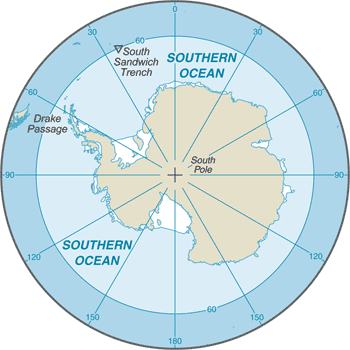body of water between 60 degrees south latitude and Antarctica
60 00 S, 90 00 E (nominally), but the Southern Ocean has the unique distinction of being a large circumpolar body of water totally encircling the continent of Antarctica; this ring of water lies between 60 degrees south latitude and the coast of Antarctica and encompasses 360 degrees of longitude
Antarctic Region
total: 20.327 million sq km
note: includes Amundsen Sea, Bellingshausen Sea, part of the Drake Passage, Ross Sea, a small part of the Scotia Sea, Weddell Sea, and other tributary water bodies
slightly more than twice the size of the US
17,968 km
sea temperatures vary from about 10 degrees Celsius to -2 degrees Celsius; cyclonic storms travel eastward around the continent and frequently are intense because of the temperature contrast between ice and open ocean; the ocean area from about latitude 40 south to the Antarctic Circle has the strongest average winds found anywhere on Earth; in winter the ocean freezes outward to 65 degrees south latitude in the Pacific sector and 55 degrees south latitude in the Atlantic sector, lowering surface temperatures well below 0 degrees Celsius; at some coastal points intense persistent drainage winds from the interior keep the shoreline ice-free throughout the winter
the Southern Ocean is 4,000 to 5,000-m deep over most of its extent with only limited areas of shallow water; the Antarctic continental shelf is generally narrow and unusually deep, its edge lying at depths of 400 to 800 m (the global mean is 133 m); the Antarctic icepack grows from an average minimum of 2.6 million sq km in March to about 18.8 million sq km in September, better than a sixfold increase in area; the Antarctic Circumpolar Current (21,000 km long) moves perpetually eastward, the world's largest ocean current, it transports 130 million cubic meters of water per second - 100 times the flow of all the world's rivers
mean depth: -3,270 m
elevation extremes: lowest point: southern end of the South Sandwich Trench -7,235 m
highest point: sea level 0 m
probable large oil and gas fields on the continental margin; manganese nodules, possible placer deposits, sand and gravel, fresh water as icebergs; squid, whales, and seals - none exploited; krill, fish
huge icebergs with drafts up to several hundred meters; smaller bergs and iceberg fragments; sea ice (generally 0.5 to 1 m thick) with sometimes dynamic short-term variations and with large annual and interannual variations; deep continental shelf floored by glacial deposits varying widely over short distances; high winds and large waves much of the year; ship icing, especially May-October; most of region is remote from sources of search and rescue
increased solar ultraviolet radiation resulting from the Antarctic ozone hole in recent years, reducing marine primary productivity (phytoplankton), damaging the DNA of some fish, and causing sun damage to some mammals; large amount of mortality of seabirds resulting from long-line fishing for toothfish; ocean acidification
note: the now-protected fur seal population is making a strong comeback after severe overexploitation in the 18th and 19th centuries
the Southern Ocean is subject to all international agreements regarding the world's oceans; in addition, it is subject to these agreements specific to the Antarctic region: International Whaling Commission (prohibits commercial whaling south of 40 degrees south [south of 60 degrees south between 50 degrees and 130 degrees west]); Convention on the Conservation of Antarctic Seals (limits sealing); Convention on the Conservation of Antarctic Marine Living Resources (regulates fishing)
note: many nations (including the US) prohibit mineral resource exploration and exploitation south of the fluctuating Polar Front (Antarctic Convergence), which is in the middle of the Antarctic Circumpolar Current and serves as the dividing line between the cold polar surface waters to the south and the warmer waters to the north
the major chokepoint is the Drake Passage between South America and Antarctica; the Polar Front (Antarctic Convergence) is the best natural definition of the northern extent of the Southern Ocean; it is a distinct region at the middle of the Antarctic Circumpolar Current that separates the cold polar surface waters to the south from the warmer waters to the north; the Front and the Current extend entirely around Antarctica, reaching south of 60 degrees south near New Zealand and near 48 degrees south in the far South Atlantic coinciding with the path of the maximum westerly winds
Fisheries in 2013-14 landed 302,960 metric tons, of which 96% (291,370 tons-the highest reported catch since 1991) was krill and 4% (11,590 tons) Patagonian toothfish (also known as Chilean sea bass), compared to 15,330 tons in 2012-13 (estimated fishing from the area covered by the Convention of the Conservation of Antarctic Marine Living Resources, which extends slightly beyond the Southern Ocean area). International agreements were adopted in late 1999 to reduce illegal, unreported, and unregulated fishing, which in the 2000-01 season landed, by one estimate, 8,376 metric tons of Patagonian and Antarctic toothfish. In the 2014-15 Antarctic summer, 36,702 tourists visited the Southern Ocean, slightly lower than the 37,405 visitors in 2013-14 (estimates provided to the Antarctic Treaty by the International Association of Antarctica Tour Operators, and does not include passengers on overflights and those flying directly in and out of Antarctica).








